 klaus-michael schneider
klaus-michael schneider
Keywords: education |
Links: FOTW homepage | search | disclaimer and copyright | write us | mirrors

Last modified: 2021-08-26 by  klaus-michael schneider
klaus-michael schneider
Keywords: education |
Links: FOTW homepage |
search |
disclaimer and copyright |
write us |
mirrors
See also:
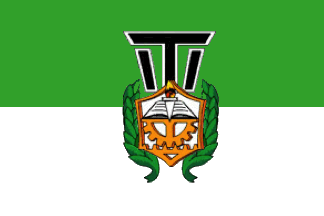 image by Ivan Sache, 17 March 2019
image by Ivan Sache, 17 March 2019
Institución Técnica Industrial Lucio Pabón Núñez (ITI) was established on 12
June 1950 in Ocaña (Norte de Santander Department). The school was renamed in
1954 to Escuela Media de Artes y Oficios and in 1965 to Escuela Industrial.
ITI Lucio Pabón Núñez was established by Decree No. 559 issued on 6 May 2003.
ITI is named for Dr. Lucio Pabón Núñez (1913-1988), one of the pushers of the
foundation of the school.
http://itienlared.blogspot.com/2009/05/fundado-el-12-de-junio-de-1950.html,
ITI website
Ivan Sache, 17 March 2019
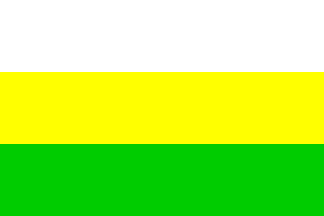 image by Ivan Sache, 28 July 2014
image by Ivan Sache, 28 July 2014
Lice o Lucrecio Jaramillo Vélez was established in 1967 in Medellín
(Antioquia Department). The institute is named for Lucrecio Jaramillo Vélez,
director of the University of Antioquia from 1965 to 1969.
The flag of the institute is horizontally divided white-yellow-green. White is a
symbol of liberty, integrity, and firmness Yellow is a symbol of life, power,
constancy, and knowledge. Green is a symbol of hope, youth, and future. White
and green are the colours of the University of Antioquia, the institute's alma
mater.
Source:
http://www.ljv.edu.co/portal/institucion/s%C3%ADmbolos-institucionales.html
- Institute's website
Ivan Sache, 28 July 2014
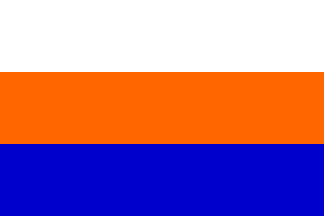 image by Ivan Sache, 10 November 2014
image by Ivan Sache, 10 November 2014
Fundación Universitaria Luis Amigó (FUNLAM) was established in 1984 in
Medellín (Antioquia Department) by the Tertiary Capuchins, a congregation
founded in 1889 by Luis Amigó Ferrer and active in Colombia since 1905. Still
headquartered in Medellín, FUNLAM operates five Regional Centers located in
Apartadó, Bogotá, Cali, Manizales, and Montería. FUNLAM is organized in the
Faculties of Administrative, Economical, and Accounting Sciences; Social
Communication and Advertizing; Law and Political Sciences; Education; and
Philosophy and Theology; Engineering; Psychology and Social Sciences.
The flag of FUNLAM is prescribed in the Manual of Corporative Visual Identity
(Special Release, 2008) as horizontally divided in three equal stripes, white,
orange, and blue. Orange and blue are the corporative colours of FUNLAM. Blue is
a symbol of knowledge, serenity, and force. Orange is a symbol of life and
dynamism.
The colours are specified as:
- Orange: Pantone 1505 C, CMYK (%) 0-42-77-0.
- Blue: Pantone 2758 C, CMYK (%) 100-80-0-26
The rules of use of the flag are:
- the flag shall not have folds;
- the flag shall not be used as a tablecloth or be covered with another flag;
- the flag shall not be either hung or fixed to a wall;
- the flag shall always be hoisted on a mast, never on a staff;
- the flag shall not touch the ground;
- the flag shall not be added ribbons or knots.
Source:
http://www.funlam.edu.co/modules/institucionalfunlam/item.php?itemid=45 -
FUNLAM website
Photos:
http://www.surgam.org/articulos/498-Especial/Fotografias/slides/COLOMBIA2.(Doctorado%20y%20Tatiana)%20033.html
http://www.surgam.org/articulos/498-Especial/Fotografias/slides/COLOMBIA2.(Doctorado%20y%20Tatiana)%20046.html
http://www.surgam.org/articulos/498-Especial/Fotografias/slides/HONORIS%20102.html
http://www.surgam.org/articulos/498-Especial/Fotografias/slides/HONORIS%20120.html
http://www.surgam.org/articulos/498-Especial/Fotografias/slides/HONORIS%20139.html
Ivan Sache, 10 November 2014
FUNLAM was transformed into Universidad Católica Luis Amigó on 10 November
2016.
Ivan Sache, 20 September 2018
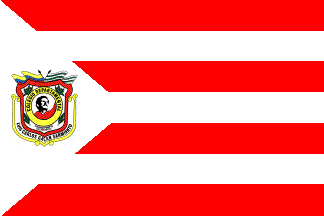 image by Ivan Sache, 10 July 2014
image by Ivan Sache, 10 July 2014
Colegio Departamental Luis Carlos Gálan Sarmiento is based in Ciudad Porfia,
part of the municipality of Villavicencio (Meta Department). The institute is
named after Luis Carlos Gálan Sarmiento (1943-1989), a Colombian journalist and
liberal politician, murdered by hitmen, probably hired by the drug cartels,
during a demonstration in Soacha (Cundinamarca Department).
The flag of
the institute is horizontally divided red-white-red-white-red-white-red with a
white triangle placed along the hoist and charged with the institute's emblem.
The flag, designed by the student Miguel Angel Melo Cujiño, was selected in an
internal contest organized in 2009. The text says that the flag is made of eight
red stripes and four white stripes, while the drawing shows it with four red
stripes and three white stripes. Red is a symbol of the blood shed for liberty
and independence, and of Luis Carlos Gálan Sarmiento's thought. White is a
symbol of peace.
The emblem of the institute is made of four main
elements: the flags of Colombia and of Meta Department, the bust of Luis Carlos
Gálan Sarmiento, and flowers, twigs and leaves. The bust of Luis Carlos Gálan
Sarmiento is a symbol of the institute's philosophy and educational principles.
The vegetal elements represent the natural environment surrounding the institute
and the immensity of the plain. Yellow is a symbol of the resources and of the
prosperity of the Meta Department.
http://www.sigueonline.co/portalcolegio/galan/index.php?lk=5 - Institute's
website
Ivan Sache, 10 July 2014
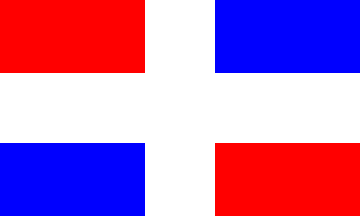 image by Ivan Sache, 7 January 2009
image by Ivan Sache, 7 January 2009
"Colegio Luis Carlos Gálan Sarmiento" is located at
Inírida, Department of Guainía.
The institute is named after Luis Carlos Gálan Sarmiento
(1943-1989), a Colombian journalist and liberal politician,
murdered by hit men, probably hired by the drug cartels, during a
demonstration in Soacha, Department of Cundinamarca.
The flag of the institute, as shown graphically and described on
the website
of the Secretary of Education of the Department of Guainía, is
white cross quartered red-blue by a white cross.
Ivan Sache, 7 January 2009
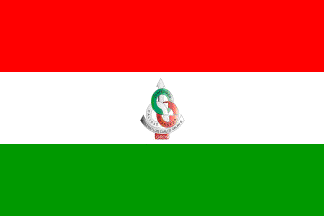 image by Ivan Sache, 31 December 2009
image by Ivan Sache, 31 December 2009
"Colegio 'Luis Carlos Gálan Sarmiento'" is based at
Girón, Department of Santander.
The institute is named after Luis Carlos Gálan Sarmiento
(1943-1989), a Colombian journalist and liberal politician,
murdered by hitmen, probably hired by the drug cartels, during a
demonstration in Soacha, Department of Cundinamarca.
The flag of the institute, as shown graphically and described on
the website of the institute (after the "Pacto de
Convivencia" of the institute), is horizontally divided
red-white-green with the emblem of the institute in the middle.
Red represents energy and the power of the ideas defended by the
institute. White represents transparency and integrity of the
members of the educational community. Green represents the
highness of the mountains and the pride and frankness of the
community.
The emblem of the institute is made of the four interlaced
capital letters "C" ("Colegio"), L
("Luis"), "C" ("Carlos") and
"G" ("Gálan"), all outlined in blue [in
black on the drawings], placed above a semi- circular scroll
charged with "COLEGIO LUIS CARLOS GALAN SARMIENTO" in
red letters [on the drawings, COLEGIO LUIS CARLOS G. in black
letters]. The emblem is inscribed in a virtual triangle whose
vertical altitude is made of an L-shaped arrow pointing to the
infinite, symbolizing universality. Below the emblem is the name
"GIRON", the seat of the institute and a component of
the national historical and cultural heritage. Blue represents
the perdurability of ideas as well as the transcendence and
highness of the inhabitants of Santander; the red letters
symbolize the fieriness of their speech and the strength of their
convictions [on the drawings, the writing is white on a red
background].
The four letters also represent four words:
- The first "C", for "Compromiso"
(Compromise), representing the pact between our great leader and
the Colombian people, fervently supported by our community;
- "L", for "Libertad" (Liberty), defended by
our charismatic policy and expressed both in teaching and
training;
- The second "C", for "Calidad" (Quality),
provided by the institute to the local youth;
- "G", for "Grandeza" (Greatness), expressed
by our director and a characteristic of all members of the
institute. The interlacing of the letters symbolizes union and
solidarity among the different members of the educational
community.
Source: lcgssedec.wordpress.com
Ivan Sache, 31 December 2009
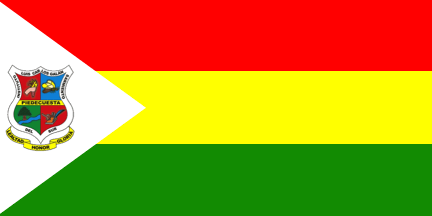 image by Ivan Sache, 10 December 2018
image by Ivan Sache, 10 December 2018
Instituto Luis Carlos Galán Sarmiento del Sur is located in Piedecuesta
(Santander Department).
The institute is named after Luis Carlos Gálan
Sarmiento (1943-1989), a Colombian journalist and liberal politician, murdered
by hitmen, probably hired by the drug cartels, during a demonstration in Soacha
(Cundinamarca Department).
The flag of Instituto Luis Carlos Galán
Sarmiento del Sur is horizontally divided red-yellow-green with a white triangle
placed along the hoist and charged with the school's coat of arms in the center.
http://briggite-sena.blogspot.com,
Briggite Garcia's blog
Ivan Sache, 10 December 2018
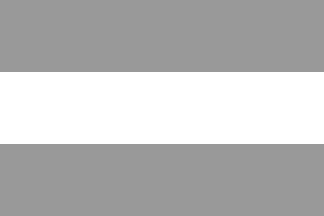 image by Ivan Sache, 16 July 2014
image by Ivan Sache, 16 July 2014
Institución Educativa Luis Carlos Gálan Sarmiento was established in San
Rafael borough, part of the municipality of Cúcuta (Norte del Santander
Department) by Municipal Decree No. 79 of 24 November 1989. The institute is
named for Luis Carlos Gálan Sarmiento (1943-1989), a Colombian journalist and
liberal politician, murdered by hit men, probably hired by the drug cartels,
during a demonstration in Soacha (Cundinamarca Department).
The flag of
the institute is horizontally divided gray-white-gray.
Gray means intelligence and innate knowledge.
White mind purity.
https://colgalancucuta.edu.co/web/nuestro-colegio - Institute's website
Ivan Sache, 16 July 2014,
10 January 2021
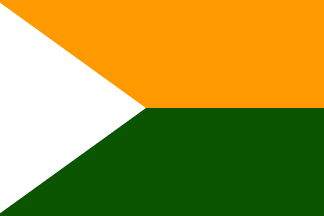 image by Ivan Sache, 01 September 2017
image by Ivan Sache, 01 September 2017
Institución Educativa Luis Eduardo Arias Reinel was established in Barbosa (Antioquia)
in 1900, as Escuela Urbana de Varones, and renamed as Escuela Luis Eduardo Arias
Reinel in 1996 by Municipal Agreement No. 3, and as Colegio Luis Eduardo Arias
Reinel in February 1997 by Resolution No. 182.
Source:
Institute's
website
The flag of I.E. Institución Educativa Luis Eduardo Arias Reinel is horizontally
divided orange-green with a white triangle placed along the hoist. The flag,
designed by Juan Bernardo Sánchez Ríos (5th primary grade, Escuela Urbana de
Varones), was adopted in 1994 following a school contest.
Orange is a symbol of energy, will and commitment.
Green is a symbol of hope.
White is a symbol of peace and harmony.
Source:
Institute's
website
Ivan Sache, 01 September 2017
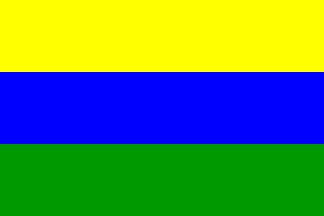 image by Ivan Sache, 28 November 2014
image by Ivan Sache, 28 November 2014
Instituto Técnico Agropecuario Luis Ernesto Vanegas Neira is located
in the village of Inspección de Rioblanco (Municipality of Rioblanco,
Tolima Department).
Escuela Rural Mixta Puerto Saldaña was built in 1970 by Father
Argemiro Vasquez. In 1980, the school was transformed into a Colegio
depending of Colegio San Rafael de Herrera, and, after 1989 of Colegio
Francisco Julián Olaya (Resolution No. 14 of 25 January 1989).
Instituto Técnico Agropecuario Luis Ernesto Vanegas Neira was
eventually established in 1997. Because of the threat of the guerilla,
the number of students dramatically deceased while most
educationalists required the transfer of the school to Ibagué, to no
avail.
The flag of the institute is described in the Institutional Education
Project as horizontally divided yellow-blue-green.
Yellow is a symbol of economical abundance.
Blue represents river Saldaña and another five rivers.
Green is a symbol of the natural environment, the crops and their
products.
Source:
http://intellectum.unisabana.edu.co:8080/jspui/bitstream/10818/2440/1/131520.pdf
Ivan Sache, 28 November 2014
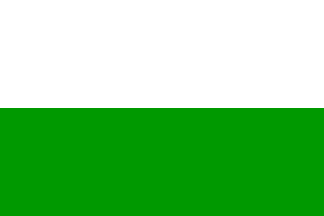 image by Ivan Sache, 17 July 2014
image by Ivan Sache, 17 July 2014
Colegio Municipal Luis Gabriel Castro was established in El Rosario (Nariño
Department) by Municipal Decree No. 10 of 7 November 1988. The institute is
named for the El Rosario-born journalist, educationalist and historian Luis
Gabriel Castro (1896-1955;
http://jesusgerardogarcia.blogspot.fr/2009/01/luis-gabriel-castro.html -
biography).
The flag of the institute is horizontally divided
white-green. White is a symbol of solidarity, responsibility, work and peace.
Green is a symbol of environment.
http://www.colcastro.edu.co/simbolos.html - Institute's website
Photos
http://www.colcastro.edu.co/images/galeria/lightbox/1392230870.jpg
http://www.colcastro.edu.co/images/galeria/lightbox/1392230915.jpg
Ivan Sache, 17 July 2014
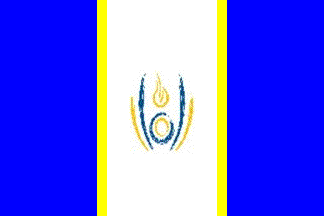 image by Ivan Sache, 03 July 2014
image by Ivan Sache, 03 July 2014
Colegio Luis López de Mesa was established in 1930 in Barrancabermeja
(Santander Department) to teach the children of the North American workers hired
by the Tropical Oil Co. Originally known as Staff Ecopetro, the institute was
renamed Colegio Directivo de Ecopetrol in 1959. The today's name of the
institute should have been adopted in a public contest organized in 1967;
however, the unexpected death of the noted teacher Luis López de Mesa caused the
cancellation of the contest and the naming of the institute for him.
Ecopetrol transferred in 2013 the management of the institute to the Aspaen
(Asociación para la Enseñanza) association, established on 1 September 1964,
grouping now 25 institutes in eight Colombian towns under the spiritual
influence, some say control, of Opus Dei.
The flag of the institute is vertically divided blue-white-blue with a thin
yellow stripe between each field, and the emblem of the institute in the middle.
Blue is a symbol of the local resources and progress opportunities, and of
creativity. White is a symbol of aspiration to peace and liberty, of
transparency and purity. Yellow is a symbol of the vitality of the soil and of
the people.
Source:
http://lopezdemesa.edu.co/quienes-somos/207-bandera - Institute's
website
The emblem of the institute is yellow and blue. Yellow represents the adults, as
the symbol of intellect, light, guidance, force, willingness and stimulus.
Blue represents the students, as the symbol of the development of intelligence
and of emotions, of infinity and of creams. The upper part of the emblem
represents light radiating over the way to knowledge and spiritual
transcendence.
Source:
http://lopezdemesa.edu.co/quienes-somos/205-logosimbolo - Institute's
website
Ivan Sache, 03 July 2014
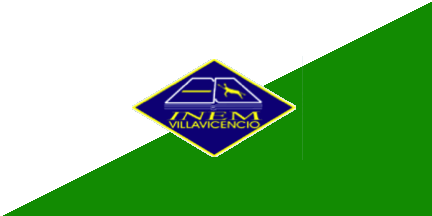 image by Ivan Sache, 18 March 2019
image by Ivan Sache, 18 March 2019
Institución Educativa Instituto National de Educación Media Luis López de
Mesa was established in 1962 in Villavicencio (Meta Department).
The flag
of the school is in proportions 1:2, diagonally divided white-green from the
lower hoist to the upper fly, with the school's coat of arms in the center.
Green symbolizes hope and the plain. White represents transparency. The two
fields of the flag represent the academic and technical areas, respectively.
http://inemvillavicencio.edu.co/bandera/
Ivan Sache, 18 March 2019